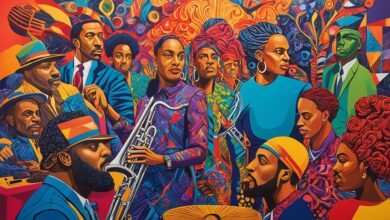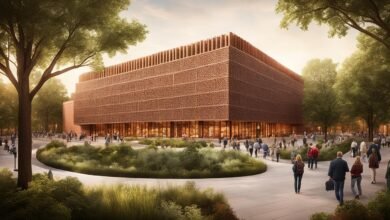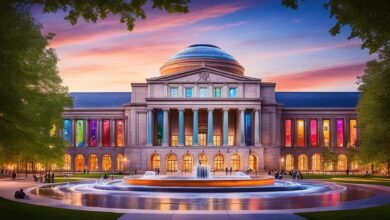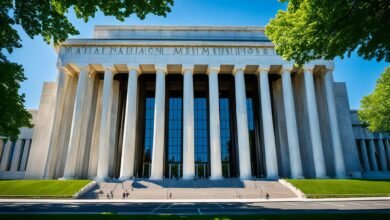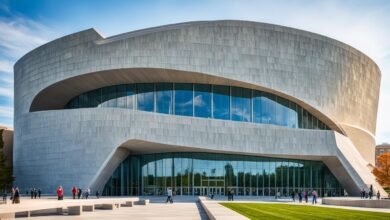Table of Contents
Did you know that the United States Holocaust Memorial Museum in Washington, D.C. has over 1.7 million visitors yearly? It stands as a reminder of the Holocaust’s horrors. It also emphasizes the need to remember and teach others about the risks of hate and discrimination.
Want to deeply understand a critical part of history? The United States Holocaust Memorial Museum is the place to go. With its moving exhibits and strong educational programs, the museum offers a memorable journey. It will touch your heart and change how you see the world.
Visit the Museum
When in Washington D.C., you must visit the United States Holocaust Memorial Museum. It’s a key place for those who value history and memory. Here, you can explore exhibits and learn about the Holocaust’s deep history.
The museum offers a deep dive into the Holocaust, from the Nazis’ rise to the camps’ liberation. You’ll find stories, artifacts, and documents. They bring the dark past alive, showing the horrors faced.
Entering the museum is free. This makes it open to all who want to honor those memories. But, you might need a timed pass for the permanent exhibition at busy times. You can get these passes online or at the museum, on a first-come basis. This helps manage the crowd, ensuring a meaningful visit for everyone.
The museum also focuses on education and memory, beyond just exhibits. There are programs, activities, and events that promote discussion and awareness. You can join lectures, watch films, and participate in events. These experiences let you connect with the Holocaust in a deep way.
Visiting the United States Holocaust Memorial Museum is more than seeing history. It’s a step against hate and bias. By going, you help keep the Holocaust’s memory alive. And you help spread the lessons it teaches us.
If you’re interested in history, activism, or just want a moving experience, visit this museum in D.C. It’s a powerful reminder of human resilience. It challenges us to fight hate and discrimination wherever they appear.
Think about the museum’s role as a place of memory, learning, and hope before you visit. Plan ahead to get your timed pass. Make your visit impactful and full of meaning.
Hours and Tickets
The United States Holocaust Memorial Museum is open daily from 10 a.m. to 5:30 p.m. It is closed on Yom Kippur and Christmas Day. Admission is free, so everyone can understand the importance of this memorial.
During certain times of the year, you need a timed pass for the museum’s main exhibit. You can get these passes either online or directly at the museum. Make sure to visit the museum’s website for the latest info on tickets and visiting hours, especially in the busy season.
Timed Passes for the Permanent Exhibition
If you want to see the permanent exhibition at the United States Holocaust Memorial Museum, you’ll need a timed pass. This pass tells you when you can enter. It helps reduce waiting and ensures everyone can fully experience the exhibits. Though the museum is free, you must get a timed pass during busy times to enter.
Here’s how you can get a timed pass:
- Online Reservations: You can book timed passes online. This lets you plan your visit in advance, so you don’t miss seeing the exhibits. But, booking online comes with a small fee.
- On-Site Passes: If you didn’t book online, you can still try for a pass at the museum. These are given out first-come, first-served. But, they might run out, especially when it’s busy.
Whichever way you choose to get your pass, visiting the museum is a deep and moving experience. Plan your visit well by getting your timed pass early.
| Opening Hours | Admission | Timed Passes |
|---|---|---|
| 10 a.m. to 5:30 p.m. (except Yom Kippur and Christmas Day) | Free | Required for permanent exhibition at certain times |
How to Get There
The United States Holocaust Memorial Museum is in Washington, D.C. It’s on the National Mall, so it’s easy to get to. You can come from different parts of the city or further away.
Metrorail
The Metrorail is the easiest way to reach the museum. The Smithsonian station is the nearest Metro stop. It’s just a block from the museum.
You need to take the Orange, Silver, or Blue lines. Then, you’ll be close to where you need to go.
DC Circulator’s National Mall Route
You could also take the DC Circulator’s National Mall route. This bus goes to many sights, including the museum. It runs every day and stops near the museum, making visits straightforward.
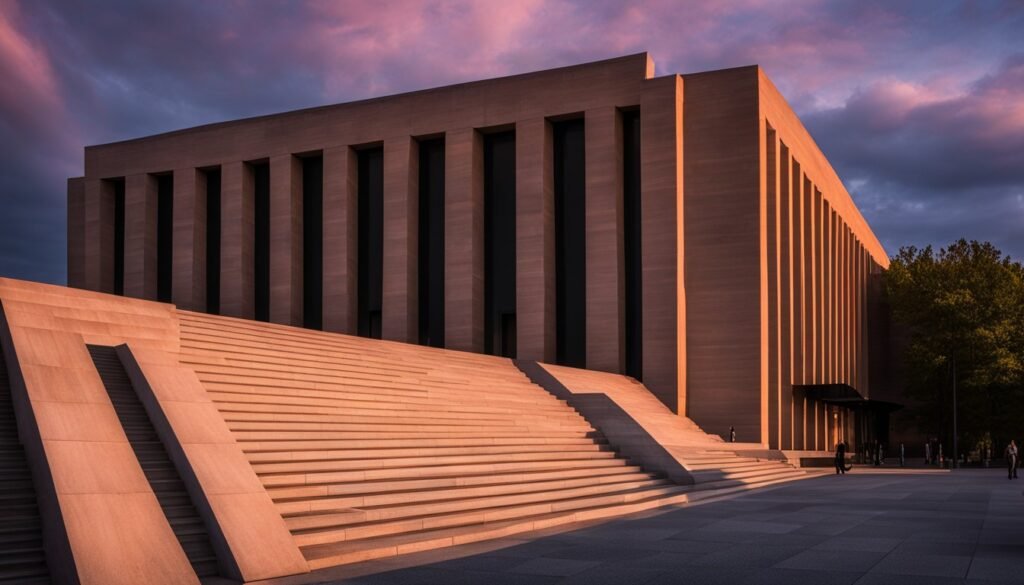
If driving is your choice, you’ll find parking garages near the museum. But, parking can be hard to find, especially when it’s busy. Public transportation is a better choice to avoid parking trouble.
The museum is ready to welcome visitors who use mobility aids. Everyone can enjoy the exhibits and facilities without trouble.
Permanent Exhibition
The heart of the United States Holocaust Memorial Museum is the “The Holocaust” exhibit. This detailed exhibit spans three floors. It gives a step-by-step look at the Holocaust, helping visitors grasp this grim time in history.
Visitors will find a huge number of artifacts, photos, and films. These items let people see and feel the horror of the Holocaust up close. With real stories and visuals, the museum tells about those who suffered during this genocide.
Personal belongings and survival stories make the exhibit very immersive. Visitors are encouraged to think and understand more deeply.
The exhibit aims to teach visitors about the countless victims of this sad period. It reminds us why we must remember them. It also motivates us to act against such horrors in the future.
It is made for people of all ages. The goal is for everyone to understand the Holocaust’s history better. Also, to motivate ongoing efforts against hatred.
Highlights of “The Holocaust” Exhibition:
- A vast collection of artifacts, photographs, and films
- Stories from survivors firsthand
- Interactive areas that add historical background
- A story that goes from the Nazis’ rise, through the camps, to liberation
- Looking at the Holocaust’s effects on various communities
- Spaces for visitor reflection to honor the victims
The United States Holocaust Memorial Museum’s main exhibit is a touching and informative journey. It shines a light on the Holocaust’s atrocities. With its broad collection and compelling stories, it helps keep the memory of this dark time alive. It encourages tolerance, understanding, and togetherness.
| Exhibit Features | Details |
|---|---|
| Artifact Collection | Lots of items like personal things, papers, and clothes show the Holocaust’s huge effect. |
| Photographs and Films | Strong images show the terrible things people and groups went through during the Holocaust. |
| Survivor Testimonies | Survivors share their stories. This lets us never forget what they went through. |
| Interactive Displays | These exhibits help visitors dive deeper into the Holocaust’s history and effects. |
| Chronological Narrative | The exhibit lays out the events before and during the Holocaust in order. This helps visitors understand it better. |
Additional Exhibits and Resources
The United States Holocaust Memorial Museum doesn’t just have a permanent exhibition. It also offers visitors many more exhibits and resources. These help people understand the Holocaust’s deep effects. They are great for learning, remembering, and thinking deeply about the past.
One of the museum’s main attractions is the Holocaust Remembrance Museum. It shares powerful stories, artifacts, and multimedia presentations. These temporary exhibits focus on the Holocaust in different ways. They look at resistance, survival, and how families and children were affected. Each one shows a new side of the Holocaust. They help us grasp the full horror and complexity of it.
The website of the United States Holocaust Museum is also a treasure trove of information. It has photos, documents, testimonies, and more. These materials help users learn about the Holocaust in detail. By exploring the site, you can understand the historical background, the survival stories, and the bigger picture of this sad time in history.
Besides online resources, the museum also organizes events and programs. There are film showings, talks by famous scholars, panels, and workshops. These help visitors dive deeper into the Holocaust’s history and its lessons. The museum encourages thoughtful conversation. It helps us see how the Holocaust’s lessons matter even in today’s world.
The United States Holocaust Memorial Museum gives visitors a unique chance to learn, remember, and reflect on the Holocaust. With its changing exhibits, online resources, and interactive events, it ensures we keep the memory of this terrible time alive. It pushes us to take meaningful action in today’s world.
| Additional Exhibits and Resources | Description |
|---|---|
| Holocaust Remembrance Museum | A rotating exhibit that explores various aspects of the Holocaust, offering unique perspectives and deepening understanding. |
| Online Resources | The museum’s extensive website provides access to collections, photographs, documents, and testimonies, enhancing remote learning and research. |
| Events and Programs | Film screenings, lectures, panel discussions, and workshops provide opportunities for in-depth exploration and dialogue. |
Health and Safety Guidelines
The United States Holocaust Memorial Museum cares deeply about the health and safety of its visitors, staff, and volunteers. Due to COVID-19, the museum has introduced guidelines to lessen the risk of spreading the virus. All visitors must follow these rules and listen to any museum instructions during their visit.
Remember these important health and safety tips when you come to the United States Holocaust Memorial Museum in Washington D.C.:
- Everyone must wear masks: All visitors, staff, and volunteers need to wear masks or face coverings inside the museum.
- Keep your distance: Stay at least 6 feet away from others not in your household or group.
- Observe directions: Follow the museum’s one-way paths and signs to keep visitor traffic smooth and safe.
- Sanitize your hands: Use the hand sanitizing stations found throughout the museum often to keep your hands clean.
- Respect area limits: Follow any rules about how many people can be in one area at a time. There might be a wait to enter certain exhibits, so please be patient.
By sticking to these rules, you help make the museum a safer place for all. Thank you for working with us to ensure a great visit for everyone.
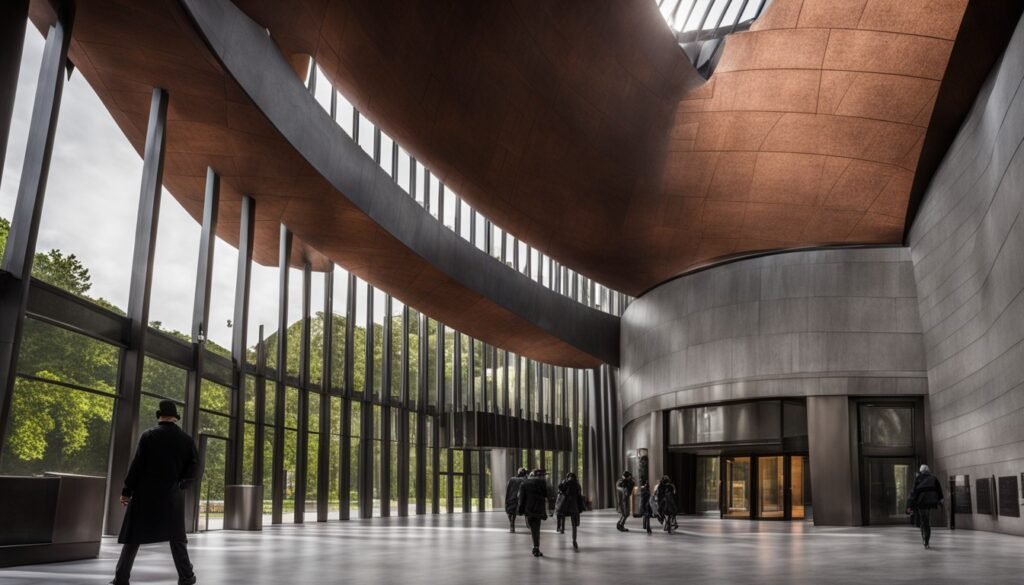
“Keeping our visitors safe is our top priority. To do this, we have set up detailed health guidelines at the United States Holocaust Memorial Museum.” – Museum Director
Museum Location and Address
The United States Holocaust Memorial Museum stands on the National Mall in Washington, D.C. It gives visitors a central spot to encounter this impactful museum. Its address is 100 Raoul Wallenberg Place SW, Washington, DC 20024.
When you plan your visit, know that the museum is near the Smithsonian Metro station. This makes it easy to get there by public transport.
If you live in the area or are visiting Washington, DC, the Holocaust memorial is easy to find. It welcomes you to explore its significant exhibits. Here, you can think about a very hard time in history.
National Events
The United States Holocaust Memorial Museum in Washington D.C. plans events all year round. They aim to remember the Holocaust and increase awareness about its impact. By doing so, they encourage people to talk about this terrible time in history and the Holocaust’s lasting effects.
Highlights of these events include talks by experts in Holocaust studies. These talks cover the Holocaust’s beginnings, effects, and what we can learn from it. They help people understand this tragic event in history better.
Survivors and eyewitnesses also share their stories at the museum. Hearing from those who lived through it makes the Holocaust’s reality hit home. These stories of survival are crucial for remembering and learning from the past.
“The national commemorations at the United States Holocaust Memorial Museum show its dedication to remembering those who suffered during the Holocaust. These ceremonies bring people together, reminding us of the evil that can come from hatred. They encourage us to fight against injustice, discrimination, and genocide.”
The museum’s events help spark discussions about the Holocaust. They invite people to learn about history and share their views. These discussions are vital for ensuring tragedies like the Holocaust never happen again.
For details on future events at the United States Holocaust Memorial Museum, please visit their official website.
Collections and Archives
The United States Holocaust Memorial Museum in Washington D.C. has over 270,000 records. These records help us understand the horrors of the Holocaust. They are crucial for learning about this dark time in history.
This museum has a wide variety of items like photos, personal stories, and films. These artifacts show life during the Holocaust and its lasting effects. They help us grasp the tragedy’s impact.
Through the museum, you can find personal stories and historical accounts. These stories make the events of the Holocaust more real. They help us feel empathy and understand the Holocaust’s effects.
The museum’s online platform makes it easy to explore these collections. It’s great for anyone wanting to learn more, like students or teachers. You can access this info from anywhere, encouraging more learning about the Holocaust.
Confronting Rising Antisemitism
The United States Holocaust Memorial Museum is at the forefront of tackling the surge in antisemitism today. It calls for colleges and universities to help fight this issue. By promoting awareness and action, the museum is key in fighting hate.
“Antisemitism is not just a Jewish problem; it is a human problem. We must all work together to challenge and eradicate such hatred from our society.” – United States Holocaust Memorial Museum
The museum works with schools to create a welcoming space for conversation and learning. It organizes activities that help students address antisemitism’s growing threat. This promotes respect and understanding.
Highlighting the horrors of the Holocaust, the museum educates on past tragedies. This empowers people to stand against bias and discrimination. Everyone is encouraged to be a force for good in making a more caring world.
By addressing antisemitism openly, the museum offers hope. It motivates everyone to act against hate and bigotry, aiming for a future of tolerance.
National Events
| Event | Date |
|---|---|
| National Commemoration | April 8 |
| Lecture Series: Confronting Antisemitism | September 22-24 |
| Panel Discussion: The Role of Education | November 12 |
These events by the museum offer a chance for people to unite and talk about fighting antisemitism. Through these gatherings, we can strive for a brighter future.
Remembering the Holocaust
The United States Holocaust Memorial Museum is a place of remembrance. It honors those who suffered during a terrible time in history. It teaches the importance of remembering the victims.
This museum educates people about the dangers of hate and genocide. Its exhibits, programs, and resources help us learn. They show why we must prevent such tragedies in the future.
Going to this museum is an emotional experience. It makes you reflect on the Holocaust’s horrors. You honor those who lost their lives and stand against antisemitism by visiting.
It also reminds us to protect human rights and dignity. The museum keeps the past alive, teaching us to be watchful.
At the museum, you’ll see artifacts, photos, and survivors’ stories. These powerful items make history feel real. They show us why we must care about today’s issues of hate and intolerance.
Engaging with the museum makes you a voice for change. It gives you the knowledge and heart to fight against bigotry. And you’ll learn how to stand for understanding among people.
The museum is a symbol of hope and memory. It inspires us to work for a better, kinder world. Your visit helps keep the spirit of hope and resilience alive.
